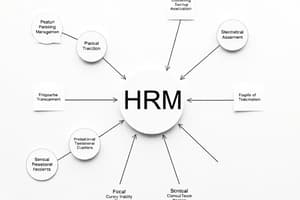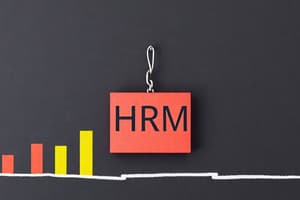Podcast
Questions and Answers
Which of the following best describes the role of Human Resource Management (HRM) in an organization?
Which of the following best describes the role of Human Resource Management (HRM) in an organization?
- To strategically manage employees, contributing to organizational objectives. (correct)
- To handle marketing and sales strategies to increase revenue.
- To oversee the supply chain and logistics operations.
- To manage financial assets and ensure profitability.
The Michigan School's 'matching model' suggests that HR systems should conflict with organizational strategy to foster innovation.
The Michigan School's 'matching model' suggests that HR systems should conflict with organizational strategy to foster innovation.
False (B)
According to the Michigan School's model, what are the four generic processes or functions performed in all organizations?
According to the Michigan School's model, what are the four generic processes or functions performed in all organizations?
Selection, appraisal, rewards, and development
According to the Harvard framework, HRM policies should aim for activities that are developed and implemented in ways that are mutually ______.
According to the Harvard framework, HRM policies should aim for activities that are developed and implemented in ways that are mutually ______.
Match the element of the Harvard Framework with its description:
Match the element of the Harvard Framework with its description:
What is the primary distinction between 'vertical alignment' and 'horizontal alignment' in people strategy?
What is the primary distinction between 'vertical alignment' and 'horizontal alignment' in people strategy?
The Standard Causal Model of HRM suggests that HR strategy is most effective when it is misaligned with the overall business strategy.
The Standard Causal Model of HRM suggests that HR strategy is most effective when it is misaligned with the overall business strategy.
According to the Standard Causal Model of HRM, improved HR outcomes such as commitment and engagement directly lead to what type of performance?
According to the Standard Causal Model of HRM, improved HR outcomes such as commitment and engagement directly lead to what type of performance?
The 8-Box Model by Paul Boselie emphasizes that the effectiveness of HR practices is influenced by eight external and ______ factors.
The 8-Box Model by Paul Boselie emphasizes that the effectiveness of HR practices is influenced by eight external and ______ factors.
Match the external force from Paul Boselie's 8-Box Model with its appropriate element:
Match the external force from Paul Boselie's 8-Box Model with its appropriate element:
In the HR Value Chain model, what is the key difference between HRM activities and HRM outcomes?
In the HR Value Chain model, what is the key difference between HRM activities and HRM outcomes?
According to the HR Value Chain model, focusing solely on HRM activities and efficiency is guaranteed to produce the best long-term results for an organization.
According to the HR Value Chain model, focusing solely on HRM activities and efficiency is guaranteed to produce the best long-term results for an organization.
What are the key enablers integrated into the HR Value Chain Advanced model?
What are the key enablers integrated into the HR Value Chain Advanced model?
The Harvard Model of HRM starts with ______ interests which then defines the HRM policies.
The Harvard Model of HRM starts with ______ interests which then defines the HRM policies.
Match the element of the Guest Model with its description:
Match the element of the Guest Model with its description:
What does the Warwick Model emphasize in aligning HRM practices?
What does the Warwick Model emphasize in aligning HRM practices?
The Ulrich Model proposes that the HR function should focus solely on administrative tasks rather than strategic alignment to improve efficiency.
The Ulrich Model proposes that the HR function should focus solely on administrative tasks rather than strategic alignment to improve efficiency.
According to the Ulrich Model, what four key roles should the HR function take on?
According to the Ulrich Model, what four key roles should the HR function take on?
Storey's Model defines 'hard' HRM as a cost-focused approach that treats employees as ______.
Storey's Model defines 'hard' HRM as a cost-focused approach that treats employees as ______.
Match the element of the 5Ps HR Model with its definition:
Match the element of the 5Ps HR Model with its definition:
Flashcards
Human Resource Management (HRM)
Human Resource Management (HRM)
Managing an organization's people to achieve its objectives.
Matching Model of HRM
Matching Model of HRM
HR systems should align with organizational strategies.
Four Generic HR Processes
Four Generic HR Processes
Selection, appraisal, rewards, and development.
Two Characteristic Features of HRM
Two Characteristic Features of HRM
Signup and view all the flashcards
Central philosophy or a strategic vision
Central philosophy or a strategic vision
Signup and view all the flashcards
Vertical Alignment
Vertical Alignment
Signup and view all the flashcards
external forces influencing HR
external forces influencing HR
Signup and view all the flashcards
Strategic HR
Strategic HR
Signup and view all the flashcards
HRM Outcomes Lead to
HRM Outcomes Lead to
Signup and view all the flashcards
Outer Context
Outer Context
Signup and view all the flashcards
Administrative Expert
Administrative Expert
Signup and view all the flashcards
Storey Model of HRM
Storey Model of HRM
Signup and view all the flashcards
The 5 P's of Hr
The 5 P's of Hr
Signup and view all the flashcards
Control-based Model
Control-based Model
Signup and view all the flashcards
Resource-based model
Resource-based model
Signup and view all the flashcards
The Integrative Model
The Integrative Model
Signup and view all the flashcards
Strategic Human Resource Management (SHRM)
Strategic Human Resource Management (SHRM)
Signup and view all the flashcards
Strategic HR
Strategic HR
Signup and view all the flashcards
Stakeholder involvemnt in Strat HR
Stakeholder involvemnt in Strat HR
Signup and view all the flashcards
factors when selecting aHR model
factors when selecting aHR model
Signup and view all the flashcards
Study Notes
- Human Resource Management (HRM) is a strategic and coherent approach to managing an organization's most valuable assets which are the people who contribute to its objectives.
Models of HRM
- HRM is the frameworks that serve as guidelines for human resource management and intersect with the HR Strategy.
The Matching Model of HRM
- Created by The Michigan School (Fombrun et al, 1984)
- HR systems and organizational structure should align with organizational strategy.
- Human resource cycle consists of four processes performed in all organizations:
- Selection: matching available human resources to jobs
- Appraisal: performance management
- Rewards: reward short and long-term achievements
- Development: developing high-quality employees
The Harvard Framework
- Created by Beer et al (1984), also known as the 'Harvard framework' by Boxall (1992)
- Problems of historical personnel management are solved when general managers develop a vision of how they want employees to be involved and developed, and understand what HR policies can achieve
- A central philosophy or strategic vision can only be provided by general managers
- Without a central philosophy or strategic vision, HRM will remain a set of independent activities guided by individual practice traditions
- Pressures create a need for a longer-term perspective of people, and consider people as potential assets, not variable costs
- HRM belongs to line managers
- HRM involves all management decisions and actions affecting relationship between the organization and its human resources
- Two features of HRM:
- Line managers take more responsibility for aligning competitive strategy and personnel policies
- Personnel sets policies governing how personnel activities are developed and implemented to be mutually reinforcing
- Advantages of the Harvard Framework as modelled by Beer et al:
- Incorporates recognition of stakeholder interests
- Recognizes importance of trade-offs between owners and employees, as well as interest groups
- Broadens context of HRM to include employee influence, work organization and supervision
- Acknowledges contextual influences on strategy, suggesting a product market and sociocultural logics
- Emphasizes that strategic choice is not driven by situational or environmental determinism
Three-Dimensional People Strategy
- The question of whether every company should adopt a similar people strategy and aim to establish best practices in each HR policy area.
- Describing people strategy as an internally coherent set of HR policies and practices has proven difficult and elusive
- There is no single ideal type of people strategy
Vertical Alignment
- An appropriate people strategy must vary according to organizational circumstances, specifically business goals and strategies.
- HR policies and practices should reflect, reinforce and support the organization’s business aims and objectives.
- A strong linkage is needed between the overall vision held by senior executives and the aims, objectives and underlying philosophy of the organization's approach to managing people.
- Ensures HR interventions become a creator, not an inhibitor, of sustained competitive advantage
- This is the link between people strategy and business-unit strategy
Horizontal Alignment
- Vertical integration is a crucial dimension of a people strategy, but not the only aspect
- This is the link between corporate and business strategy as a whole and the firm’s people-management strategy
- The second dimension operates at the level of individual HR policy areas
- The goal is a consistent approach to managing people that permeates the HR function and other organizational areas
- Involves policy level
- Treat putting people strategies into action as a separate dimension
- High horizontal alignment means the organization has developed and articulated clear HR policies that consistently relate to one another
- The goal is to communicate consistent and reinforcing messages to employees
Standard Causal Model of HRM
- Derived from similar models published in the 90s and early 2000s
- HR strategy is only effective if allied with the business strategy.
- HR processes impact the organization
- Model begins with company's business strategy, which influences HR strategy and processes, and leads to improved business performance.
Examples of HR Processes
- Hiring, training, appraisal, and compensation practices can lead to commitment, quality output, and engagement
- HR and HRM outcomes lead to improved internal performance, such as better ROI, financial turnover, and profits
Factors that influence HR effectiveness
- The four external forces that influence how organizations do HR:
- External general market context
- External population market context
- External general institutional context
- External population institutional context
How external forces affect HR
- Shortage of certain skills in the market affects how companies recruit, source, and hire, compared to having an abundance of qualified workers
- Legislation, trade unions, and work councils control what HR can and cannot do
Core elements of HR
- The company's history, culture, and technology all influence how HR communicates what it wants to achieve and how effective HR policies are
- HR strategies and practice elements have four parts:
- Intended HR practices
- Actual HR practices
- Perceived HR practices
- HR outcomes
- Critical HR goals consist of cost-effectiveness, legitimacy, and flexibility
- Ultimate business goals are viability, profit, market share, and market capitalization
HR Value Chain
- One of the best-known models created by Paauwe and Richardson (1997)
- HR can be divided into two categories:
- HRM activities
- HRM outcomes
Aspects of strategic human resource management (SHRM)
- What is “Strategy”:
- Strategy is an action business owners take to attain their business goals
- Creating a business strategy guides business owners in what they will be doing long-term which lead to informed decision-making
- Three subsidiary concepts:
- Competitive advantage (Porter, 1985)
- Distinctive capabilities (Kay, 1999)
- Strategic fit (Hofer & Schendel, 1986)
SHRM vs HRM
- Strategic HR is focused on long-term outcomes, and operational HR is focused on short-term outcomes
- Goals in operational HR focus on managing in-house recourses, and strategic HR keeps business goals in mind when doing recourses planning
- Strategic HR managed by stake holders in senior management, and operational HR managed by a single team
- Strategic HR is dependent on advanced analytics
HRM Value Chain
- HRM activities & processes:
- Workforce Planning
- Recruitment & Selection
- Compensation & Benefits
- Industrial Relations
- Training
HRM - outcomes
- Employee Engagement
- Retention
- Absenteeism (sickness)
- Competency Levels
- Performance
- Workforce Costs
- Talent Metrics
Studying That Suits You
Use AI to generate personalized quizzes and flashcards to suit your learning preferences.




